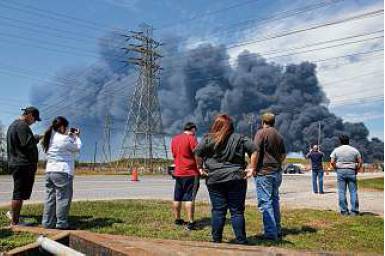TCEQ proposal rankles advocates
By Emily Foxhall STAFF WRITER
Industrial disasters in recent years have caused more concerning air pollution readings than winter storms or hurricanes, state regulators say. The findings highlight what many Houstonians may already know: There’s a critical need for monitoring air quality when chemical facilities and refineries explode or catch fire.
When it comes to responding to natural disasters, though, officials from the Texas Commission on Environmental Quality say their new data analysis shows air quality may not be widely affected and so the agency may not need to deploy as broadly as it has in the past.
“We could do a more targeted approach and focus exactly where there may be issues,” said Craig Pritzlaff, director of the agency’s office of compliance and enforcement.
To the consternation of environmental advocates, the agency found it could benefit by sending out air monitoring crews after storms only in places where officials suspect a problem is occurring. The agency would no longer do precautionary checks across the region.
The conclusion that monitoring after storms may not need to be so widespread clashed directly with what environmental groups say have been woefully slow mobilizations in past emergencies. TCEQ keeps and maintains its mobile air monitoring vans in Austin, a three-hour drive from Houston’s plentiful refineries and petrochemical plants. It often shuts down its high-tech stationary monitors ahead of storms to protect the equipment.
Only recently did TCEQ outfit a regional monitoring van for its Houston office.
In the new analysis that TCEQ released Friday, experts reviewed data its scientists collected during six major events between 2017 and 2021. They were especially motivated by information they said dozens of staff members collected after industrial plants shut down in response to last February’s winter storm. Staff sought to figure out when, where and for how long the agency should deploy its mobile air monitoring units going forward.
But the notion of TCEQ scaling back some of its emergency response concerned clean air advocates. To start, the agency didn’t have enough monitoring data from immediately after storms to draw the conclusion that it would be better to do more targeted monitoring, said Elena Craft, the senior director of climate and health for the Environmental Defense Fund. Instead, she argued the agency was letting its preferred conclusion drive its science.
“There’s plenty of evidence that in the aftermath of these weather events that those are some of the most critical times in terms of air pollution — during which the communities are most vulnerable,” Craft said, adding, “I think that they’re trying to justify a level of inaction and a level of inadequacy that doesn’t meet their responsibilities to these communities.”
For this report, the agency pulled records from air quality readings taken using various methods, including handheld monitors, specially equipped vans and a plane operated by the Environmental Protection Agency that can rapidly detect pollution as it appears in the air.
Researchers looked at the data from hurricanes Harvey, Laura and Delta and Winter Storm Uri as examples of natural storms. They drew their industrial findings from readings following the Intercontinental Terminals Co. fire near Deer Park and the Texas Petrochemical Group fire in Port Neches.
Of the samples collected during natural events (1,399,321 readings), 23 were above the level at which the agency begins to be concerned about potential effects on human health and 288 were above the level it begins to be concerned about a noticeable smell. Of the industrial event samples (1,581,912 readings), 215 went above the health safety standards and 43 surpassed the appropriate levels for smell.
Staff noted that industrial events may come hand in hand with public health protections, such as shelter-in-place or evacuation orders, as happened during the ITC fire. They also cautioned that many of the readings that were too high were taken over seconds and therefore they could not be used to draw conclusions about health.
And while the report did acknowledge the gap in the data collection when the storm impacts were at their worst, the agency argued that hurricane winds blow the pollution around, making it less concentrated in the air people might breathe. Pritzlaff added that the agency couldn’t send people out when it was too dangerous, either. And he noted facilities don’t start up again, all at once, after storms.
“We believe we have a robust network around to capture most incidents and we try to get out in the field — well, we do get out into the field as absolutely quickly as we can as an agency,” he said.
But Corey Williams, research and policy director of Air Alliance Houston, registered these findings differently. He highlighted what Pritzlaff also conceded, that every storm was different. To draw conclusions prematurely about how the agency should be monitoring natural disasters, he said, was going to leave leaders their with “egg on their face.” emily.foxhall@chron.com
